On 16 March 2005, Kim Livengood and I walked along the Katy Trail south of Rocheport, about 30 km west of Columbia, MO, looking for bats in the hour and a half after sunset. It was still, with no clouds and a bright moon a little less than half illuminated. It was coldish - about 5 degrees C. The Katy Trail runs along the edge of the Missouri River in this area, following a disused railway. At frequent intervals along the trail, it passes right beside substantial bluffs - vertical cliffs where the river has cut through a series of parallel ridges. These bluffs are typically about 50 m high and 100 m wide, and they face west adjacent to the river, so they can be expected to get a lot of exposure to the afternoon sun. They seemed ideal places to look for bats early in the season when conditions are still generally cold.
At every bluff, there was a lot of activity from Big Brown Bats Eptesicus fuscus. What struck me most was the frequent detection of calls which sounded quite unlike typical Big Brown Bat echolocation calls. From an Anabat detector, these calls sounded like brief, explosive trills - quite unlike search phase echolocation calls in all their immense variability, and also quite different to feeding buzzes. These trills were heard at every bluff we visited, and were being heard almost the whole time we were detecting Big Brown Bats.
I have heard these calls before, but very rarely. I have sometimes seen brief sequences of calls from Big Brown Bats which I thought showed some analogy to the so-called directive calls of Pallid Bats Antrozous pallidus. More recently, I have seen several examples of these trills in a dataset collected from a passive detector set up on the edge of the Meramec River at Meramec State Park, also in Missouri. This monitoring station has been running since late November 2004, and there have been occasional examples of trills in late November, late December, January and more commonly in February and March.
In addition to the trills, we noticed behaviors which I have not seen before in this species. At several bluffs, I saw Big Brown Bats circling repeatedly in front of the cliffs, their trajectories taking them perhaps 10 m from the cliff at the farthest point and much less than a metre at the closest approach. On at least 6 occasions, we saw a bat land on the rock surface. Most of these landings were brief, lasting about one second. On one occasion, the bat then scurried for a few cm before flying off. On two occasions, the bats scurried several cm up into crevices in the rocks and were lost from sight. I don't know to what extent these behaviors might have been influenced by my spotlight.
Trills were recorded from some of the circling bats, and they were also recorded from both bats of a pair involved in a chase - where one bat followed closely behind the other for about 30 seconds. In most situations though, it was difficult to be sure a trill came from a particular bat, because there were nearly always more than one bat present at a time and there was no obvious behavior associated with the trill which would make it clear where the sound originated.
Each trill consisted of two phases, the first consisting of three to five calls of relatively low slope and fairly consistent frequency. The second phase is more like a feeding buzz, with the times between pulses shorter than in the first phase, but more consistent than in a feeding buzz, without the tendency to tighten up to very short intervals towards the end. The second phase was generally hard to detect and often not seen at all. The following description therefore applies to the first phase only.
The first phase pulses varied considerably in both frequency and shape with some calls much steeper than others. Characteristic Frequency (Fc) values varied from about 19 to 45 kHz, but this is confused by the fact that some of these were detected on the first harmonic while others were principally detected on the second. It seems clear that calls with Fc around 20 kHz are on the first harmonic, while calls with Fc around 40 kHz are on the second harmonic, but it is less clear what is happening with some calls which have Fc about 30 kHz. There is one instance (shown below) of calls showing third harmonics, and quite likely another showing fourth harmonics. Times between pulses varied from 28 to 42 milliseconds, but most were between 30 and 35 ms. Durations varied from 4.2 to 11.3 ms, but most were between 7 and 10 ms, with shorter values at least mostly due to missed parts of calls. Numbers of pulses in the first phase varied from 3 to 5, but most showed 4 or 5 and it is quite possible that the cases of three were due to calls being missed because the bat was too far away. In one file, I recorded a total of 11 trills, five from one bat and 6 from another bat, all in a period of just over 9 seconds.
Below I provide seven examples of Big Brown Bat call sequences, the first two of typical search-phase and hunting sequences and the later five of trills. All these sequences were recorded on the Katy Trail on 16 March 2005. All are displayed at a time resolution of 25 milliseconds per 40 pixels, which corresponds to F7 in Analook. The frequency scales are all the same, and logarithmic. Note that I use the terms 'call' and 'pulse' as synonymous.
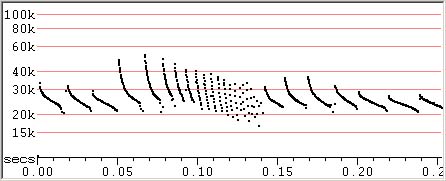
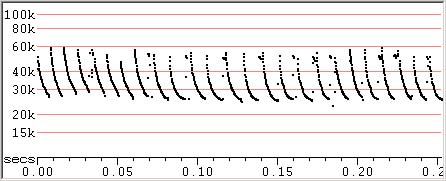
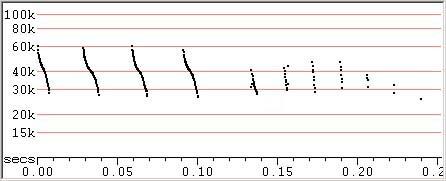

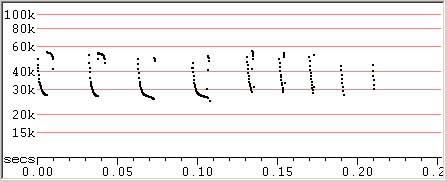
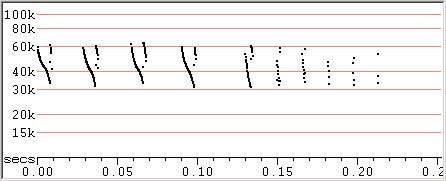
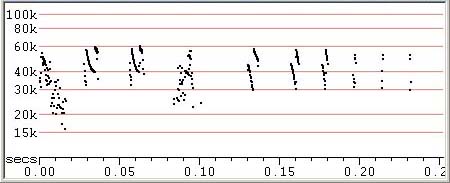
So what are these calls, and what is going on with all this social activity at this time of year? To me the whole performance looked like courtship displays. Is it feasible that Big Brown Bats could be mating in mid March? If so, it might be reasonable to regard these trills as songs. They resemble other bat songs I have seen, being stereotyped sequences of pulses that clearly differ from echolocation calls. Any ideas?
Back to: Bat Notes contents, Anabat Contents, Home